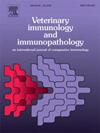Breed-specific humoral immune responses to lumpy skin disease vaccination and its associated factors in cattle
IF 1.4
3区 农林科学
Q4 IMMUNOLOGY
引用次数: 0
Abstract
Aims
To evaluate the humoral immune response to the initial Lumpy skin disease (LSD) vaccination in three cattle breeds, namely Korean native cattle (Hanwoo), Holstein, and Jersey, up to 18 weeks post-vaccination.
Methods
Overall, 65 cattle were vaccinated with the live attenuated Neethling strain of the LSD vaccine (Lumpyvax®, MSD Animal Health). Antibody titers were measured using ELISA from blood samples collected before and at 3, 6, 9, 12, and 18 weeks post-vaccination. Pre-vaccination complete blood count parameters were analyzed to determine their correlation with antibody responses.
Results
Significant breed-specific differences were observed in antibody titers and seropositivity rates. Eighteen weeks post-vaccination, Holstein cattle exhibited the most significant increase in LSD antibody concentrations, followed by Hanwoo and Jersey cattle (p < 0.05). Additionally, Holstein cattle achieved the highest seroconversion rates (73.3 %), whereas Hanwoo cattle showed the lowest seropositivity (33.3 %) during the same period. Additionally, pre-vaccination immune cell profiles, particularly lymphocyte and basophil levels, were correlated with antibody responses, emphasizing the role of innate immunity in vaccine efficacy.
Conclusions
We should consider breed-specific immune responses and pre-vaccination immune cell profiles when developing vaccination strategies. Tailored approaches may enhance vaccine efficacy and improve disease control across different cattle breeds.
Clinical Relevance
We evaluated the antibody titers across different cattle breeds following LSD vaccination, providing critical insights into breed-specific vaccine efficacy. These findings support the development of tailored vaccination strategies, contributing to improved disease prevention, control measures, and overall livestock productivity.
牛瘤状皮肤病疫苗接种对品种特异性体液免疫反应及其相关因素
目的评价三个牛品种,即韩国本土牛(Hanwoo)、荷斯坦牛和泽西牛,在接种后18周内对最初的肿块性皮肤病(LSD)疫苗的体液免疫反应。方法选用65头牛接种LSD疫苗(Lumpyvax®,MSD Animal Health)的针刺减毒活株。在接种前和接种后3、6、9、12和18周采集血液样本,采用ELISA法测定抗体滴度。分析接种前全血细胞计数参数以确定其与抗体反应的相关性。结果在抗体滴度和血清阳性率方面存在明显的品种特异性差异。接种18周后,荷斯坦牛的LSD抗体浓度升高最为显著,其次是韩宇牛和泽西牛(p <; 0.05)。此外,在同一时期,荷斯坦牛的血清转化率最高(73.3 %),而韩宇牛的血清阳性率最低(33.3% %)。此外,接种前免疫细胞谱,特别是淋巴细胞和嗜碱性粒细胞水平,与抗体反应相关,强调了先天免疫在疫苗效力中的作用。结论在制定疫苗接种策略时应考虑品种特异性免疫反应和疫苗接种前免疫细胞谱。量身定制的方法可以提高疫苗效力,改善不同牛品种的疾病控制。临床相关性我们评估了不同牛品种接种LSD后的抗体滴度,为品种特异性疫苗的有效性提供了重要见解。这些发现支持制定有针对性的疫苗接种战略,有助于改善疾病预防、控制措施和整体牲畜生产力。
本文章由计算机程序翻译,如有差异,请以英文原文为准。
求助全文
约1分钟内获得全文
求助全文
来源期刊
CiteScore
3.40
自引率
5.60%
发文量
79
审稿时长
70 days
期刊介绍:
The journal reports basic, comparative and clinical immunology as they pertain to the animal species designated here: livestock, poultry, and fish species that are major food animals and companion animals such as cats, dogs, horses and camels, and wildlife species that act as reservoirs for food, companion or human infectious diseases, or as models for human disease.
Rodent models of infectious diseases that are of importance in the animal species indicated above,when the disease requires a level of containment that is not readily available for larger animal experimentation (ABSL3), will be considered. Papers on rabbits, lizards, guinea pigs, badgers, armadillos, elephants, antelope, and buffalo will be reviewed if the research advances our fundamental understanding of immunology, or if they act as a reservoir of infectious disease for the primary animal species designated above, or for humans. Manuscripts employing other species will be reviewed if justified as fitting into the categories above.
The following topics are appropriate: biology of cells and mechanisms of the immune system, immunochemistry, immunodeficiencies, immunodiagnosis, immunogenetics, immunopathology, immunology of infectious disease and tumors, immunoprophylaxis including vaccine development and delivery, immunological aspects of pregnancy including passive immunity, autoimmuity, neuroimmunology, and transplanatation immunology. Manuscripts that describe new genes and development of tools such as monoclonal antibodies are also of interest when part of a larger biological study. Studies employing extracts or constituents (plant extracts, feed additives or microbiome) must be sufficiently defined to be reproduced in other laboratories and also provide evidence for possible mechanisms and not simply show an effect on the immune system.

 求助内容:
求助内容: 应助结果提醒方式:
应助结果提醒方式:


